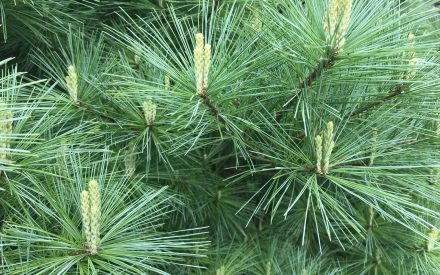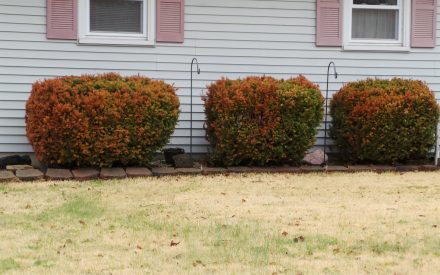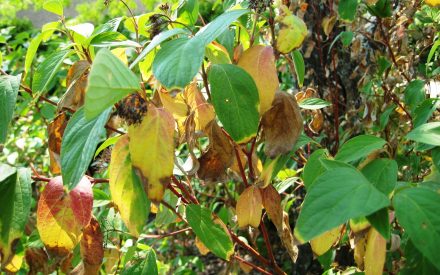
What is Volutella blight?
Volutella blight is a common and potentially lethal disease of Japanese pachysandra (Pachysandra terminalis), an evergreen, semi-woody groundcover that is grown in shade gardens throughout hardiness zones 4 and 5 in Wisconsin. Volutella blight can severely limit the aesthetic appeal of pachysandra wherever it is grown.
What does Volutella blight look like?
Volutella blight begins as discrete, water-soaked areas (lesions) on pachysandra leaves and stems that eventually turn black/brown and become necrotic (i.e., die). Lesions can be circular, oval or irregular in shape, and may have darker margins. Distinct concentric rings also may be visible in the lesions. Lesions on a single leaf can merge and cause the collapse of the entire leaf, while stem lesions can lead to the collapse of an entire pachysandra plant. When severe, Volutella blight can kill large patches of a pachysandra planting.
Where does Volutella blight come from?
Volutella blight is caused by the fungus Volutella pachysandricola which survives in infected plants, as well as on and in pachysandra plant debris. During wet weather, this fungus produces masses of light-orange to pink fungal spores and hyphae (i.e., fungal threads) that may be visible to the naked eye.
How do I save a plant with Volutella blight?
Remove diseased leaves, as well as any leaf debris, and prune back or dig up plants with stem infections. Dispose of this material by burning (where allowed by local ordinance), burying or hot composting it. Be sure to prune only when plants are dry to minimize the spread of the causal fungus. Be sure to clean your pruning tools between cuts by treating them for at least 30 seconds in a 10% bleach solution or (preferably due its less corrosive properties) 70% alcohol (e.g., rubbing alcohol, certain spray disinfectants). If you use bleach, be sure to thoroughly rinse and oil tools after you are done pruning to prevent rusting.
When disease is severe, follow leaf and plant removal by treating remaining plants with one or more applications of a broad-spectrum fungicide (e.g., one containing chlorothalonil). Select a product that is labeled for use on pachysandra, and follow all label instructions to ensure that you apply the product in the safest and most effective way possible.
How do I avoid problems with Volutella blight in the future?
V. pachysandricola is a somewhat opportunistic pathogen, most often causing problems on pachysandra that is weakened or under stress. Therefore, reduce any stresses where possible. Reduce stress due to overexposure to sun by always planting pachysandra in a shady area. Do not overcrowd new plantings, and thin existing beds to not only reduce stress from competition but also to promote good air flow and rapid drying of plants. Dry plants are less likely to become infected than plants that stay wet for extended periods. To prevent water stress during the summer and reduce winter injury over the winter, established pachysandra should receive approximately one inch of water per week during the growing season up until the point where there is snowfall or the ground freezes. Newly planted pachysandra should receive approximately two inches of water per week. If there is insufficient rain, water plants using a soaker or drip hose. Minimize salt usage on sidewalks or driveways near pachysandra beds to limit salt injury that can predispose plants to infection. Control insect pests and avoid over-pruning of pachysandra to limit wounds that might serve as entry points for V. pachysandricola.
For more information on Volutella blight:
Contact the University of Wisconsin Plant Disease Diagnostics Clinic (PDDC) at (608) 262-2863 or pddc@wisc.edu.
Authors: Gina Muscato and Brian Hudelson, UW-Madison Plant Pathology
Last Revised: 03/02/2024
D-number: D0123
References to pesticide products in this publication are for your convenience and are not an endorsement or criticism of one product over similar products. You are responsible for using pesticides according to the manufacturer’s current label directions. Follow directions exactly to protect the environment and people from pesticide exposure. Failure to do so violates the law.
Thanks to Diana Alfuth, Laura Jull and Christine Regester for reviewing this document.
A complete inventory of UW Plant Disease Facts is available at the University of Wisconsin-Madison Plant Disease Diagnostics Clinic website: https://pddc.wisc.edu.
Send a Plant Sample for Analysis
Be cautious when self-diagnosing plant health issues. Very few diseases can accurately be diagnosed by eye.
Contact the UW Plant Disease Diagnostics Clinic (PDDC), and for a small fee, clinic staff can examine a plant, determine the cause of the disease/disorder, and provide advice on how to control or prevent the issue.
Download Article





 Pruning Evergreens
Pruning Evergreens Winter Burn
Winter Burn Drought and Watering of Ornamental Plants
Drought and Watering of Ornamental Plants Conifer Disease Quick Reference
Conifer Disease Quick Reference


